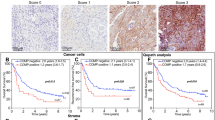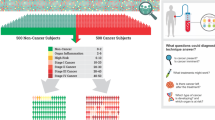Summary
Circulating vascular endothelial growth factor-C (VEGF-C) and vascular endothelial growth factor (VEGF) levels in patients with colorectal carcinoma were determined in order to assess their clinical significance as a diagnostic tool for monitoring lymph node metastasis. In 66 patients with colorectal carcinoma and 30 healthy controls, circulating VEGF-C and VEGF levels were assessed by using enzyme-linked immunosorbent assay (ELISA). Serum VEGF-C and VEGF levels were higher in patients with colorectal carcinoma than in healthy controls. Patients with lymph node metastasis had higher serum VEGF-C and VEGF levels than those without lymph node metastasis. The levels of VEGF-C and VEGF were higher in the invasion group than in the non-invasion group. Serum VEGF-C levels reached a sensitivity of 81% and a specificity of 76% with a cutoff value of 1438.0 pg/mL, whereas VEGF levels reached 72% sensitivity and 74% specificity at 240.2 pg/ mL If 66 patients were divided into 4 groups according to the combined determination of VEGF-C and VEGF levels, the positive predictive value was 85.3%, the negative predictive value was 94.6% and accuracy was 93.7%. It was suggested that circulating VEGF-C levels might provide additional information for distinguishing the absence from presence of lymph node metastasis in patients with colorectal carcinoma. The combined determination of VEGF-C and VEGF levels could be used as an important index for preoperatively clinical stage of colorectal carcinoma.
Similar content being viewed by others
References
Xu T W, Chen D D, Chen J Y. Expression of vascular endothelial growth factor C and its correlation with lymph node metastasis in colorectal carcinoma. J Huazhong Univ Sci Technol [Med Sci], 2004, 24:596–598
Kaio E, Tanaka S, Kitadai Yet al. Clinical significance of angiogenic factor expression at the deepest invasive site of advanced colorectal carcinoma. Oncology, 2003, 64(1):61–73
Ohta Y, Tamura Met al. Serum vascular endothelial growth factor-C level in patients with primary nonsmall cell lung carcinoma—A possible diagnostic tool for lymph node metastasis. Cancer, 2003, 98:1217–1222
Long Z Q, Li J. Study of serum vascular endothelial growth factor-C level in patients with primary human esophageal squamous cell carcinomas—A possible marker of lymph node metastasis. China J Modern Med. 2005, 15(19):2885–2888
Amilka T, Kitadai Y, Tanaka Set al. Vascular endothelial growth factor C expression predicts lymph node metastasis of human gastric carcinomas invading the submucosa. Eur J Cancer, 2002, 38:1413–1419
Tille J C, Nisato R, Pepper M S. Lymphangiogenesis and tumor metastasis. Novartis Found Symp, 2004, 256: 112–131; discussion 132–136, 259–269
Author information
Authors and Affiliations
Additional information
XU Tianwen, male, born in 1973. Doctor in Charge
Rights and permissions
About this article
Cite this article
Tianwen, X., Daoda, C. Serum vascular endothelial growth factor-C and vascular endothelial growth factor level in patients with colorectal carcinoma and clinical significance. J. Huazhong Univ. Sci. Technol. [Med. Sci.] 26, 329–331 (2006). https://doi.org/10.1007/BF02829566
Received:
Issue Date:
DOI: https://doi.org/10.1007/BF02829566




